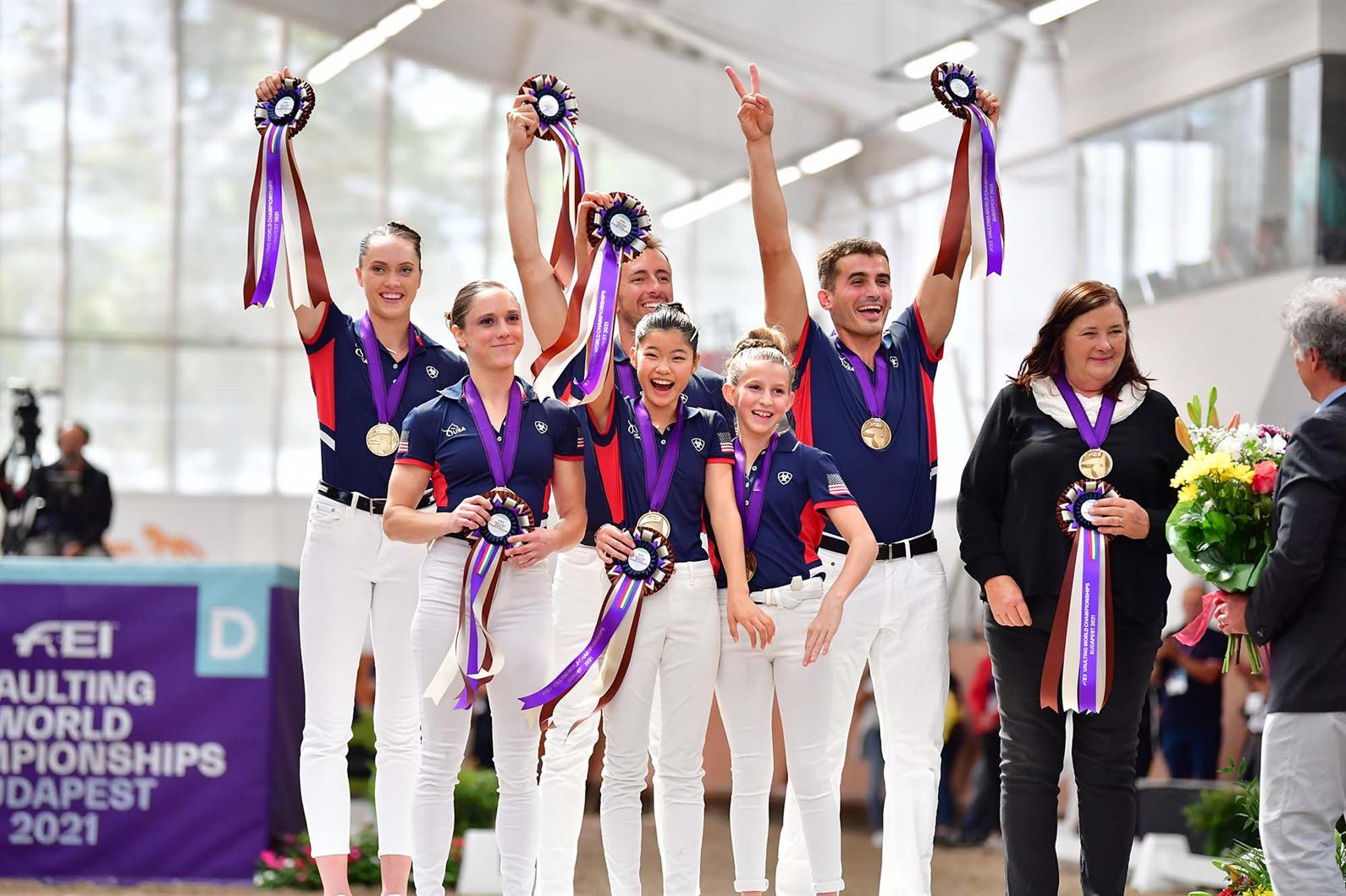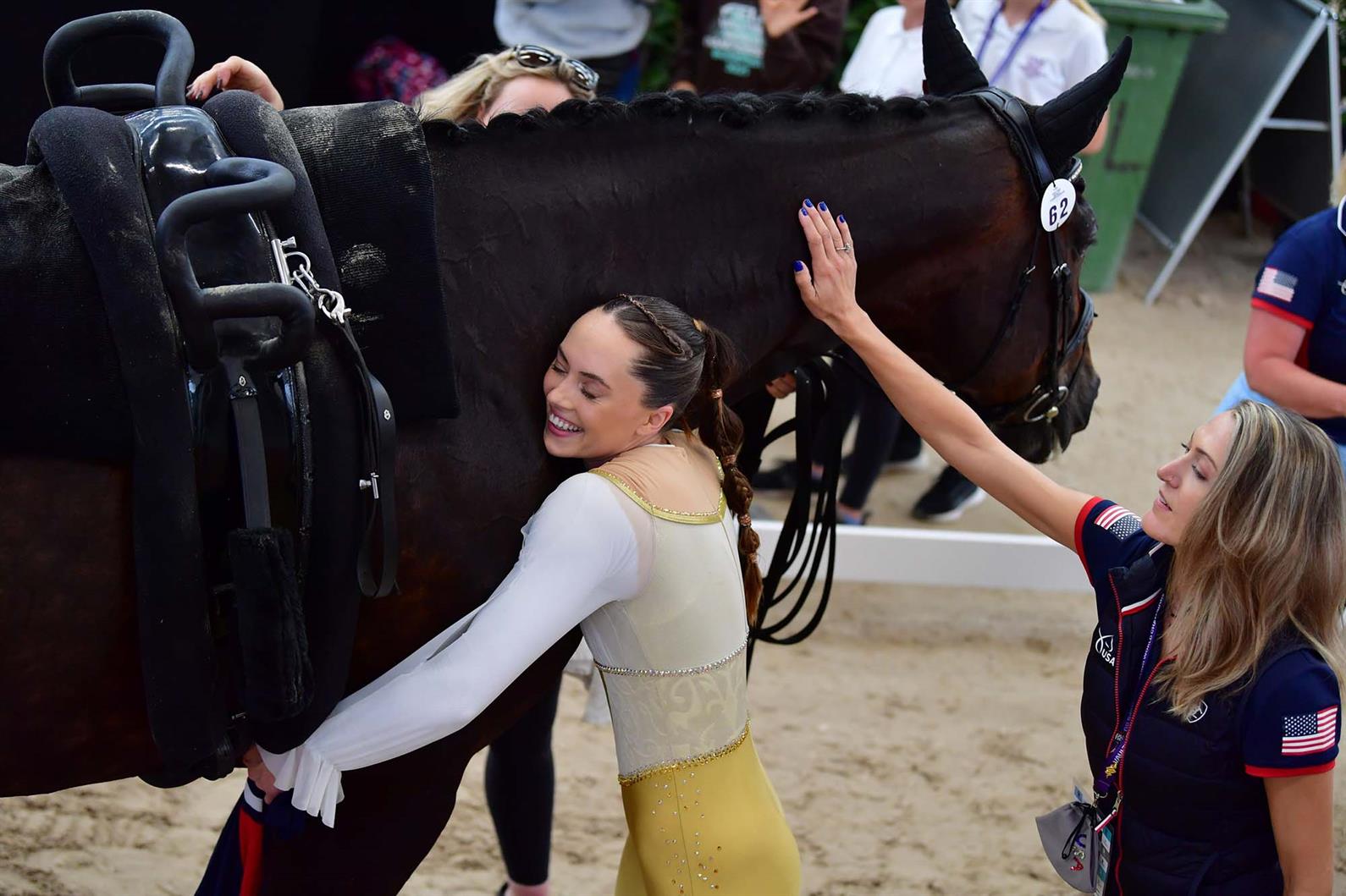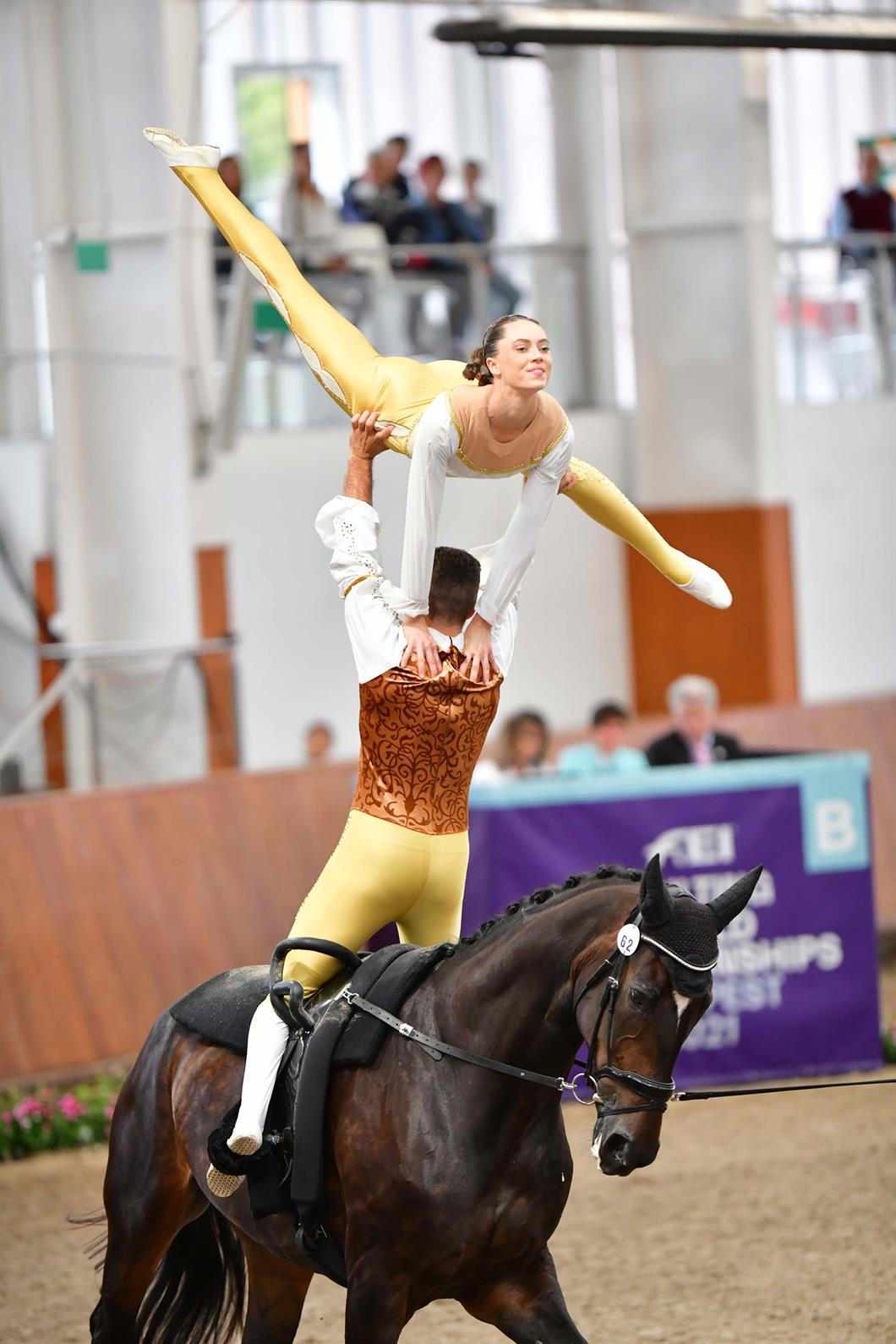Athletes from the U.S. Vaulting Team had a historic outing at the FEI Vaulting World Championship for Seniors last month in Budapest, Hungary, bringing home bronze medals in the Pas-de-Deux and Squad divisions. This marks the first time that American vaulters have won a medal at a senior World Championship since Megan Benjamin and Blake Dahlgren won bronze in 2012.
Haley Smith (Woodside, Calif.) and Daniel Janes (Moss Beach, Calif.) were the medal-winning pair in the Pas-de-Deux. They were also part of the squad that made the podium this year, along with Emily Rose (Santa Cruz, Calif.), Hannah Wildermuth (Pottsville, Pa.), Geoffrey Woolson (Tujunga, Calif.), and Emi Yang (Los Altos Hills, Calif.) Longeur Carolyn Bland and her 18-year-old Oldenburg mare, Diva 506, rounded out the U.S. squad’s roster under the direction of Chef d’Equipe Jennifer Arntsen.

The Tests
At the FEI level, vaulters may compete in four divisions: individual male; individual female; pas-de-deux; and squad, which consists of six vaulters. Vaulters often compete in multiple divisions.
At a championship, the first test for individuals and squads is a compulsory test, where athletes demonstrate proficiency in seven set exercises. All divisions then complete a freestyle test to determine qualifications for round two, where they will perform a second freestyle test for final placings. Because the Pas-de-Deux division at a championship doesn’t include a compulsory exercise, all of the weight falls on the freestyle tests.
“The Pas-de-Deux performs two freestyle rounds,” Smith explains. “Most pairs stick with the same routine and theme for both rounds. Daniel and I decided to push the envelope and perform two separate routines. This idea set us apart from other competing nations at the championship, helping us secure a medal.”
Through choreography, music, and costume, a vaulting freestyle is an opportunity to tell a story while showcasing the vaulters’ incredible skill.
“Our squad’s theme this year was based on the concept of the six elements working together to create life on earth,” says Smith. “This theme allowed for a lot of imagination and fun in the creation and development of moves. For example, one of our flyers who is tossed in the air was representing the element of helium while her bases were representing oxygen and carbon.
“Our Pas-de-Deux represented two different themes,” Smith continues. “The first had been shown before on the international stage and was a crowd favorite. This was a theme of two aliens who were first unsure of each other and their surroundings, and slowly began to understand each other on a deeper level to create something beautiful by working together and not against one another.

“The second routine was developed to look as if we were performing a modern dance atop our horse,” says Smith. “The theme was inspired by the artist Woodkid and his song ‘Central Park,’ with the lyrics, ‘Love is on top, stopping pain.’ Our interpretation of this song was to represent all of the struggles and sacrifices that it took to finally be able to compete at a championship again and to demonstrate that if the love of the sport is on top, nothing can stop you from achieving your dreams.”
The Four-Legged Teammate
Because of the expense and logistics associated with transporting a horse overseas, U.S. vaulters are not always able to bring their own horse to major competitions in Europe and will vault on horses borrowed from other teams. But at this year’s World Championship, the team had their horse, Diva 506, with them in the ring.
“We were very thankful this year to be able to raise enough money to bring our golden teammate, Diva!” says Smith. “This made a huge difference for our team’s success as we were able to perform our routines on a horse that we knew and trusted. Diva was our ticket to having a spot on the podium as we relied on her incredible performance throughout the show.”
To be successful in vaulting, a horse must have the strength and athleticism to carry themselves along with up to three vaulters at once, all while maintaining a steady canter on the circle for the duration of a routine. Diva is one of the best there is, with an international vaulting career dating back to the 2010 Alltech FEI World Equestrian Games™.
“Diva is an incredible horse and teammate. She always puts her best foot forward and knows when to shine,” says Smith, noting that when it comes to her personality, Diva lives up to her name. “She is queen of her own talent and always owns the ring when she’s competing.
“Diva has been to three World Equestrian Games, making her a very experienced vaulting horse,” adds Smith. “We knew that our team’s chance of medaling in Hungary depended on having a great horse behind us, which is why we made the decision to fly her all the way from Northern California. She’s a great vaulting horse because she loves what she does and always has our backs as athletes. She has an incredibly smooth and rhythmic canter, which allows the vaulting to come naturally on her.”
Cross-Training
Smith says that Diva’s training ahead of the World Championship consisted of minimal work on the vaulting circle and lots of cross-training in dressage to keep her in top fitness. She says that the vaulters do most of their training on the ground or on the practice barrel, which allows horse and human athletes to stay fit and sound.
Smith rides dressage alongside her vaulting career, and is currently looking ahead to competing in Prix St. Georges at the California Regional Dressage Championships with Sir Charles, a 2004 Hanoverian gelding who is owned by and competes in vaulting with the Pacific Coast Vaulting Club.
“Dressage and vaulting are two sports that truly go hand-in-hand,” she says. “I’m able to take the skills that I’ve learned in vaulting, such as balance and harmony, and bring that directly to the movements in dressage. I’m an advocate for having well-developed vaulting horses, and I believe that dressage is a perfect cross-training tool for them. The horses benefit from more training in balance, suppleness, and strength to then carry high-level vaulting routines with ease.”

Coming Back After COVID
Teamwork takes on an added level in vaulting, where trust and harmony are essential for high-flying stunts on horseback. Smith and her teammates have benefitted from several years of training together and prior experience at top competitions.
“Daniel and I have been working together in a Pas-de-Deux since 2018 when we competed at the FEI World Equestrian Games,” she says. “Our squad has been training together since 2018, also competing at WEG. After the games, we formulated a new plan of success, bringing on two top-level flyers, Hannah Wildermuth and Emi Yang! With this addition, our team was unstoppable in the U.S. and soon to be on the international stage.”
In 2020, the COVID-19 pandemic altered the team’s plans and forced the athletes to come up with new ways to stay physically and mentally fit and healthy. Unlike other equestrian sports, vaulting requires close contact between humans, so traditional training was off the table.
“As athletes, it was very important to be willing to adapt and have understanding during the pandemic,” says Smith. “Our team learned to quickly adapt to the circumstances and chose to move all training to in-home Zoom sessions where we were able to focus on developing both strength and mental training. Our team horses went to dressage boot camp during this time where they could develop more strength, balance, and suppleness.”
Reflecting over the past year, Smith says that the downtime offered some benefits for the team. With the opportunity to take a step back and reaffirm their goals, the team members came back with a renewed dedication to achieving their dreams, and that dedication was on display at this year’s World Championships.
“We were very thankful as athletes to have the opportunity to compete at a World Championship after the pandemic,” says Smith. “Despite not having a roaring crowd as we entered the ring to compete, the organizing committees of the FEI still managed to make the event in the incredible city of Budapest one to remember! The atmosphere created at the championship by all parties was incredibly special and heartwarming as everyone was so thankful to be competing at a top-level competition again. Protocols aside, we could not have been happier to represent the United States at such a prestigious event.”
Follow US Equestrian
For competition updates, follow USA Vaulting on Facebook and US Equestrian on Facebook, Twitter, Instagram, and TikTok. Use #USAVaulting.


